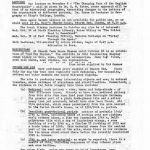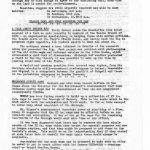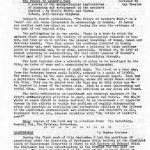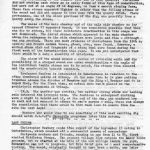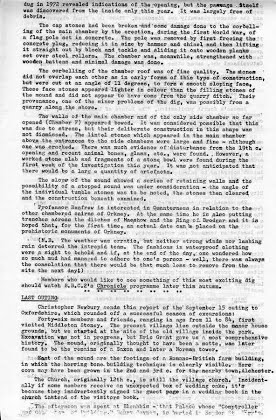
Page 1
As promised in our September Newsletter an interim report on the Church End dig appears below. The site continues to provide interest — both to diggers and to sundry onlookers, one of was heard to inquire last week — “Are these allotments for hire?”
Lectures
Our lecture on 6 November — “The Changing Face of the English Countryside” — will be given by a Dr. E. M. Yates, whose approach will be that of an historical geographer, describing changes in the pattern of the countryside at different periods. Dr. Yates is Lecturer of Geography at King’s College, London.
Once again Hendon Library is not available for public use, so we shall meet at St. Mary’s Church House, Church End, Hendon, at 8.15p.m.
The local library lectures in October may also be of interest:
Wednesday 24 October at North Finchley Library, Peter Willey on “The Golden Road to Samarkand”
Wednesday 31 October at East Finchley Library, Malcolm Colledge on “Turkey through the ages”
Both lectures, illustrated by colour slides, begin at 8.15p.m. Admission is free.
Exhibitions
At Church Farm House Museum until 14 October is an exhibition of “Old Toy Trains”. The exhibits in this fascinating display range widely in date, size, type and accessories. Many toy firms, some well-known, some obscure, are represented.
Church End Dig
From notes supplied by Ted Sammes.
Work continues every weekend at Church end. Since July the digging has been opened regularly each Wednesday, for housewife, retired and other members who enjoy midweek digging.
The site is producing many interesting objects and now, in several trenches, shows evidence of structures and stratification. Summarised, the evidence so for falls roughly into three periods:
(a) Medieval: much pottery — rims, bases and body-sherds — of four different types. Already we have more medieval pottery from this site than came last year from Burroughs Gardens. The greater part of a plain dark-glazed tile and a silver penny (not yet precisely dated) have also been found. All this material, which comes principally from the area nearest to the Parish Clerk’s House, is of 13th/14th century period.
(b) Immediate post-Medieval period: pottery of probable 16th/17th century date, including bases of cooking pots and pipkins, early tobacco pipes, a fine but incomplete 17th century Delft polychrome tile with a dog of lugubrious visage, a rose farthing of early 17th century, a Charles II farthing of 1673 and a trade token of 1669. This material comes from the central part of the west end of the site, where there is now evidence for the house which stood there before the recently demolished nineteenth-century houses.
(c) Eighteenth century and later material: as might be expected, there is a wealth of this, including sequences of clay tobacco pipes and wine bottles.
Two other finds, which may prove to be of importance, are:
A dozen or so bricks, found at various places in the area, similar to the small yellow-grey type discovered last year at Burroughs Gardens and identified by Guildhall Museum as of Medieval date. To find so many, unstratified, leads to the hope that some may be found in situ. Although bricks of this type are known other parts of London, they are not common and little has yet been discovered about their precise use in the type of small domestic building which will probably have stood at Church End. Should they be found in position a valuable addition might be made to the knowledge of vernacular building in the London area.
Page 2
Secondly, a pattern of post-holes appears to be emerging on the northern side of the site, suggesting possible evidence for a wooden-framed structure of some type.
These finds, coupled with the size of the site (much of it has not yet been investigated) has led us to ask the London Borough of Barnet to extend the finishing date of the dig beyond 31 October. We hope the Borough may be kind enough to agree to our continuing until such time as the land is needed for redevelopment.
Meanwhile, diggers are still urgently required and will be most welcome: on Saturdays, 2-6 p.m. on Sundays 10-6 p.m. on Wednesdays 10.30-5 p.m.
PLEASE COME AND HELP WHENEVER YOU CAN.
A talk about Church End
Percy Reboul sends the Newsletter this brief account of a talk he gave recently to members of the Hendon Branch of MIND — an organisation specialising in helping those with mental problems. The Branch meets at St. Mary’s Church House, and having seen the dig in progress right opposite, its members wanted to know all about it.
The audience showed a keen interest in details of the research which had preceded the dig. Each person was provided with photo-copies of the old tithe maps and relevant entries in the tithe books, which stimulated a good deal of discussion. Although bad weather prevented a visit to the dig itself, it was possible to make up for this by passing round some of the finds.
A varied and amusing question time covered are many topics, from Sir Mortimer Wheeler’s still-remembered performances in Animal, Vegetable and Mineral to a comparison between the graffiti in Pompeii and those in the pedestrian underpass at Hendon Central.
Ordnance Survey Maps
Members may have seen a recent letters in The Times about the Minister for the Environment’s announcement that some Ordnance Survey maps may be discontinued as they are not considered economically viable.
HADAS has been trying slowly to build up a collection of 25 in. O.S. maps to cover the Borough of Barnet. This is the scale which is the most useful both for excavation and fieldwork. So far we have managed to cover only about one third of the Borough.
Mr. Rippon’s announcement therefore comes as something of a blow, since it suggests that the 25 in. maps may be affected before we can complete our collection. To buy at one go the maps for the remaining two thirds of the Borough would cost more than we can afford.
It has been suggested that there are many members who have single sheets of the 25 in. maps which they bought for special purposes and now no longer require, and that they might be prepared to add these to the Society’s stock. This would be on the understanding that if they wished at some later date to consult the maps again these would always be available.
Any member who has such maps and is prepared to make such an offer is asked to get in touch either with Ted Sammes or Brigid Grafton Green.
Book Reviews
The Regni, by Barry Cunliffe. Paperback published by Duckworth at £1.69. Reviewed by Ted Sammes.
This is one of a series of the Peoples of Roman Britain, to be published under the editorship of Keith Brannigan, F.S.A. It outlines the territory of the Regni tribe, which ran from Beachey Head to St. Catherine’s Hill at Winchester, and traces the history during the Roman occupation.
Page 3
Urban and rural settlement patterns are dealt with separately. The important communication routes which helped industry and the economy generally are discussed. There is a final chapter on the late 4th and the 5th centuries.
Regni territory contained such important sites as Bignor, Fishbourne, Pevensey and Portchester, on which Professor Cunliffe is well able to speak. The book has 46 illustrations and a good bibliography. One looks forward to future volumes, especially that on the Cantiaci (whose territory was roughly Kent) and perhaps also the Catuvellauni who, among other places, roamed across North Middlesex.
The Future of London’s Past.
A survey of the archaeological implications of planning and development in the nation’s capital — by Martin Biddle and Daphne Hudson, with Carolyn Heighway — reviewed by Ann Trewick.
Rescue’s fourth publication, “The Future of London’s Past”, is a must for those interested in archaeology in London. It makes one realise just how close we are to losing for ever the evidence of the past of our capital city.
The publication is in two parts. There is a book in which the author’s first summarise the history of archaeological research in London, and then go on to outline the present knowledge of Roman, Saxon and Medieval London. Then they assess the problems involved in London archaeology and, most important, outline a solution to these problems which is practical and, to my mind, essential. Without it, by 1990 at latest according to calculations, all that still remains of London’s buried past will have been destroyed — a horrifying thought.
The book includes also a schedule of sites to be developed in the City, an index of maps and a comprehensive bibliography.
The second part consists of eight maps. The first is a base map, from the Ordnance Survey scale 1:2500, reduced to the scale of 1:5000. The other seven, in the same scale, are on transparent paper. Each has a particular theme – No. 2, for example, shows all major Roman sites in the City. This can be placed over the base map so that the sites can be located in terms of the modern city. This is a most interesting and useful idea. Users can make their own additions as new sites are found.
The whole publication is a pertinent and thorough analysis of the City’s archaeological situation in past, present and future. The £3.50 which it costs (£2.50 to Rescue members) is an investment — it supports Rescue in its efforts to tackle the problems of rapidly disappearing sites and provides an intriguing and informative addition to the Library of the individual archaeologist and historian. And shouldn’t we all, Londoners that we are, concern ourselves with “The Future of London’s Past?”
NOTE: copies of the book may be obtained from the Secretary of Rescue.
Quanterness
By Daphne Lorimer.
During the first week of this September I had had the privilege of excavating under the direction of Professor Colin Renfrew in the chambered cairn of Quanterness (reported by Barry in his History of Orkney) which the Professor has been investigating in the Orkneys for the past two seasons. The cairn is situated at the foot of the northern flank of Wideford Hill, overlooking Quanterness and the Bay of Firth and adjacent to the farm of the same name (OS ref: 3417 0129). The mound was built on the tip of a spur, which has been rendered free-standing by the digging of a quarry ditch on the east side — from which was obtained the stone for the construction of the cairn.
The cairn had been opened some time in the nineteenth century and was found to consist of a central chamber 21 ft long, 6 ft 6 in. wide and 11 ft 6 in. high, orientated in a north-south direction. There were six subsidiary chambers — two either side and one either end — and the entrance was thought to be through a passage opening onto the east side of the mound.
Page 4
Trenches dug in 1972 revealed indications of the opening, but the passage itself was discovered from the inside only this year. It was largely free of debris.
The cap stones had been broken and some damage done to the corbelling of the main chamber by the erection, during the first World War, of a flag pole set in concrete. The poll was removed by first freeing the concrete plug, reducing it in size by hammer and chisel and then lifting it straight out by block and tackle and sliding it onto wooden planks set over steel rollers. The chamber was, meanwhile, strengthened with wooden battens and minimal damage was done
The corbelling of the chamber roof was of fine quality. The stones did not overlap each other as in early forms of this type of construction, but were cut as an angle of 11 degrees, to form a smooth sloping face. These face stones appeared lighter in colour than the filling stones of the mound and did not appear to have come from the quarry ditch. Their provenance, one of the minor problems of the dig, was possibly from a quarry along the shore.
The walls of the main chamber and of the only side chamber so far opened (Chamber F) appeared bowed. It was considered possible that this was due to stress, but their deliberate construction in this shape was not dismissed. The lintel stones which appeared in the main chamber above the entrance to the side chambers were large and fine — although one was cracked. There was much evidence of disturbance from the nineteenth century opening and recent animal bones, glass, etc., were found. However, a worked stone slab and fragments of a stone bowl were found during the first week of the investigation this year. It was not anticipated that there would be a large quantity of artefacts.
The slope of the mound showed a series of retaining walls and the possibility of a stepped mound was under consideration — the angle of the individual tumble stones was to be noted, the stones then cleared and the construction beneath examined.
Professor Renfrew is interested in Quanterness in relation to the other chamber to cairns of Orkney. At the same time he is also putting trenches across the ditches of Maeshow and the Ring of Brogdar and it is hoped that, for the first time, an actual date can be placed on the prehistoric monuments of Orkney.
(N.B. The weather was erratic, but neither strong winds nor lashing rain deterred the intrepid team. The fashions in waterproof clothing were a sight to behold and if, at the end of the day, one wondered how so much mud had managed to adhere to one’s person — well, there was always the consolation that there would be that much less to remove from the site the next day!)
Members who would like to see something of this most interesting dig should watch BBC2s Chronicle programme later this autumn.
Last Outing
Christopher Newbury sends this report of the September 15th outing to Oxfordshire, which rounded off a successful season of excursions:
Forty six members and friends, ranging in age from 11 to 84, first visited Middleton Stoney. The present village lies outside the manor house grounds, but we started at the site of the old village inside the park. Excavation was not in progress, but Eric Grant gave us the most comprehensive history. The mound, originally thought to have been a motte, was later found to be the remains of a Saxon and later a Norman tower.
East of the mound are the footings of a Romano-British farm building, in which the herring bone building technique is clearly visible. Here corn may have been grown in the second and third century for the nearby town, Alchester.
The Church, originally twelfth century, is still the village church. Incidentally if some members receive an unexpected box of wedding cake, it’s because they inadvertently signed the guest page in a wedding book in the Church instead of the visitors’ book.
The afternoon was spent at Blenheim — that Palace whose “Comptroller and Conductor of Buildings”, Henry Joynes, is buried in Hendon St. Mary’s churchyard

